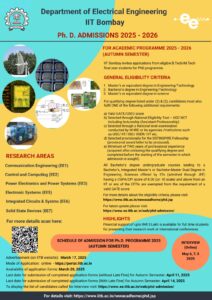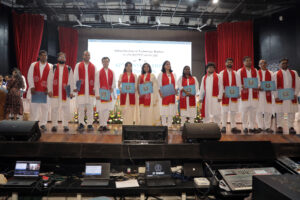EE6104 – Internet of Things
Module 1: IoT Introduction and Fundamentals
● IoT Definition, Applications, Benefits/challenges
● IoT layers and components: Sensors, signal processing, data transmission (wired/wireless), data analysis.
● IoT levels based on complexity
● IoT hardware and computing platforms
Lab: (2 labs)
1. IoT kit introduction: Hardware and software (programming environment), IDE
2. Embedded software relevant to microcontroller and IoT platform
3. Introduction to peripheral interfacing related to IoT-system design (Sensor, ADC, and wireless module available on kit). This can include SPI/I2C etc.
4. Peripheral interfacing like LEDs/ keys (display, keypad)
Module 2: Signals, Sensors, Actuators, Interfaces
● Sensors, different types/classes of sensors, Sensor parameters: non-idealities, Sensitivity, SNR, power/energy, form-factor
● Sensor read-out, ADCs, interfacing of sensors
● Datasheet aspects relevant to sensors, sensor selection
● Basic signal processing (sampling, filtering, quantization, computation, storage)Lab: (1 lab)
1. Interfacing sensor, ADC with the available board, programming for interfacing minimum of two sensors (temperature, soil moisture) simultaneously
2. Interfacing actuatorsModule 3: Networking, Communication and computing● Introduction to basic Communication Network functioning: Layers, Spectrum bands used for IoT communications, Challenges in Networking of IoT Nodes
● IoT node access methods, technologies and protocols: WiFi, 5G, MQTT, LPWAN, LoRa, , IEEE 802.15.4, etc
● Cloud computing
● Optional: Other related topics
■ Machine-to-Machine (M2M) and IoT Technology Fundamentals, Medium Access Control (MAC) Protocols for M2M Communications
■ 5G Cellular Networks and 5G IoT Communications, Low-Power Wide Area Networks
■ Wireless Communications and Networking: channel models, power budgets, data rates
■ IoT security and privacyLab: (3 labs)
1. Interfacing or using wireless modules with available boards/kits
2. Communication protocol for connectivity of IoT-CPS system with cloud (IoT platform)
3. Connectivity of gateway to cloud server and control using dashboard/webpage
4. Protocols for node communication to gateway/internet/cloud, and also among nodes (send-receive data)
Module 4: Data Analysis
● Preprocessing, data handling, and computing with Python
● Basic statistics and probability relevant to IoT data analysis
● Linear regression, clustering, classification
● Supervised and unsupervised learning, distributed learning
● Visualization (dissemination)
Lab: (2 labs)
1. To use and analyze data collected from sensors/cloud
2. Bring in closed loop application of data analytics (like controlling action/ alert)
3. Perform classification/prediction based on collected data
4. Use of basic visualization for data interpretation
Module 5: Case studies and Project
* Discuss IoT case studies (these could be running throughout the modules)
Lab: (2 labs)
o Put together a complete and practical IoT system with possibly more than one nodes connecting to a gateway. This will be connected to the cloud to perform data analysis, make inference, and provide actuating
signals.
Text/References:
1) Jacob Freden, Handbook of Modern Sensors – Physics, Designs, and Applications, 4th ed, Springer, 2010.
2) James F Kurose and Keith W Ross, Computer Networking: A Top-Down Approach, 6th ed, Pearson, 2012.
3) Arsheep Bagha and Vijay Madisetti, Internet of Things – A Hands-on Approach, Orient Blackswan Private Ltd., 2015.
4) David Hanes, et.al., IoT Fundamentals: Networking Technologies,
Protocols, and Use Cases for the Internet of Things, Pearson, 2017.
5) Harry G Perros, An Introduction to IoT Analytics, CRC Press, 2021.
6) Relevant articles from journals related to IoT.



